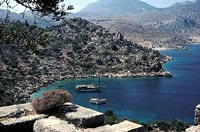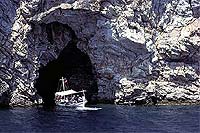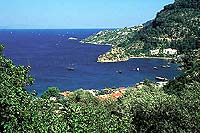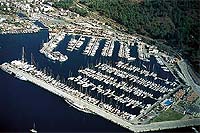
PLACES TO VISIT
Marmaris Castle: The castle, which is claimed to have been built by the Ionians, was repaired during the period of Alexander the Great, and was extended and repaired by Kanuni Sultan Süleyman during the Rhodes expedition (1522). It is possible to watch an extraordinary Marmaris panorama from the castle day and night.
Taşhan ve Arched Bridge: Tashan (Muğla road 10 km.) In İskelebaşı district, was built by Kanuni Sultan Süleyman according to her inscription with its masonry arch bridge.
Ancient Cities
Physkos: It is possible to see the ruins of Physkos, an important port city of the ancient Caria region, on the Asar hill in the north of Marmaris. The fortification walls on these ruins (Acropolis) have preserved their existence until today.
Loryma (Bozukkale): The town of Loryma, which was connected to Kasara, was established in the area known as Oplosika (tophane) twist in Bozuk Bay on the south-west end of the Bozburun peninsula. The most impressive building in the settlement area is the well-preserved berkitma located on Burunbaşı overlooking the bay entrance. There are nine rectangular towers on the edges of this island of Rhodes, which is built with smooth cut stone masonry. Today, only the tower in the north can be seen.
Amos: It is possible to reach the ancient Amos ruins from the northwest of Kumlubük Bay, from the hill called Asarcık, south of the steep coast. Amos consists of a theater, a temple and some sculptural bases located on a hill.
Cedrae: (Cleopatra or city islands) Saray Island (Cleopatra Island) On the Island of the City Islands, which consists of three islands, the Middle Island and the Small Island, there is an ancient Cedrae ruin from the Roman era. Remains of the walls can be easily selected from afar.
In the small bay on the northwest side of the island, there is a very interesting beach narrated by the people that Cleopatra swims. According to the legend, this smal

l bay is the place where Cleopatra and Mark Antony entered the sea, and the sand of this place was brought by ships from North Africa by Antonius. It is said that this type of sand can only be seen in Egypt today.
The ruins of the building surrounded by walls on the eastern part of the palace island are from the Roman period. It is the Small Theater building in the best condition. A Christian basilica was built on the foundations of the temple of the Apollo of the Dorians in the following centuries. There is an Agora in the western part of the palace island. It is understood from

some inscriptions that athletics festivals were organized in honor of Apollo in this region. Remains of the necropolis on the small island can be seen on the island with other finds and column reliefs.
Hydas: On the Erine – Bybassios road route, Hydas, which is 35 km away from Marmaris, has wall ruins and a monumental grave monument to the south of these ruins. There is a watchtower on the beach, 3 km from Hydas, and several tombs on it. The ancient town of Hydas was established in Selimiye Bay (Kamisli Bay), north of the Bozburun peninsula.
Erine: When you turn south towards Bozburun on the 20th km of the road leading to Datça in the southwest of Marmaris, you can reach Hisarönü village with a 2 km asphalt road. The ancient ruins can be reached by a 3 km stabilized forest road from here. There are Roman ruins in Erine.
Castabus (Pazarlık): This ancient ruin is in Pazarlık area near the village of Hisarlık. This holy place on the Eren mountain can be reached by an hour’s climb from the Hisarönü plain. The temple is located on the platform made for itself. The Ionian structure dating from the 4th century BC also carries Doric elements. On the platform, the temple foundation can be seen. The eye-catching walls supporting the platform have survived to this day. The ruined theater located in the area in the south is the only structure that can be defined in the region with the temple.
Saranda (Söğüt): It is 45km away from Marmaris, near the village of Söğüt today. Saranda, which continues to be an uninterrupted settlement unit during the Roman and Byzantine Periods, does not have a few remains of buildings belonging to the late Byzantine period.
Bybassios: On the way to Erine, when the direction of Bozburun is continued, the remains of the ancient city of Bybassios are encountered. Today’s Orhaniye village is located on the slope of the hill where the ruins are located. The city wall ruins are located on a scattered land in the forest.
Euthenna (Altınsivrisi): In the region to the west of the Cedrai-Marmaris line, there are two important towns connected to Rhodes in ancient times. The fenced wall that turns the residential area is in a very good condition. On the shore, an extension of the ancient pier built with the style of a dam cut stone wall is encountered. You can go there from Karacasöğüt village road.

Tombs and Mosques
Sariana Tomb: The mausoleum has a bird’s eye view to the city from the northeast in Sarıana neighborhood. There is a new mosque next to it. Kanuni visits Fatma Ana (Sarıana), who is famous for her prophecies before embarking on the Rhodes expedition. After receiving a positive response, he starts the siege of Rhodes. Before his departure from Marmaris, thousands of Ottoman soldiers have a breakfast with milk milked from the cow of Sarıana.
İbrahim Ağa Cami: It was built by İbrahim Ağa in Kemeraltı neighborhood in 1789. The large dome on it attracts attention from the architectural perspective.
BEACHES
Paradise Island: The island, which can be reached with a 30-minute journey to Marmaris, is actually a peninsula and completely covered with forests. Paradise Island, where service units such as hostels and restaurants are available, is the frequent destination of tour boats throughout the season and is a suitable place for swimming and entertainment.
Phosphorus Cave: This natural cave, which is frequented by tour boats for Turunç and Kumlubük, provides the opportunity to swim in green and turquoise waters resembling an aquarium.
İçmeler: İçmeler, which is 10 km away from the district, attracts attention with its drinking facilities that are good for the digestive system as well as being one of our few touristic places with its beach and entertainment places.
Turunç: It is possible to reach Turunç village, which is 21 km away from Marmaris, by sea or highway. The village, known to be an old fishing town, attracts the attention of local and foreign tourists with its tourist facilities, pensions and gazebo restaurants with all kinds of comfort.
Kumlubük: It is possible to reach Kumlubük, which is reached by a 6 km road from Turunc, also can be reached by sea from Marmaris. The region where green and blue intertwine is one of the most favorite beaches of the region with its clean sea and wonderful sand.
Çiftlik: It is also possible to reach Çiftlik village, which can be reached by a 2-hour journey by sea, through Bakır village. With its large sandy beach and gazebo restaurants, it is a bay especially preferred by yachtsmen for accommodation. The village, which has a small island in the bay, is also preferred by jeep-type vehicles and those who have a safari tour.
Günnücek: In Günnücek, which is 2 km away from Marmaris, there is a very rare daily (Liquidamber orientalis) forest in the world. Sweetgum oil obtained from these trees is used in the pharmaceutical and perfumery industry.
Yalancı Boğaz: This piece of land, which is 8 km away from the district, was named as the “Strait of the Bosphorus” after a ship captain thought that the Bosphorus opening the gulf in a stormy weather and placed his ship ashore. This region, where tree-made Gulet shipyards are located, is one of the must-see places.

